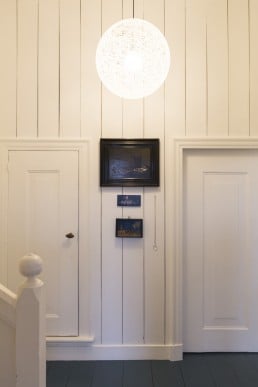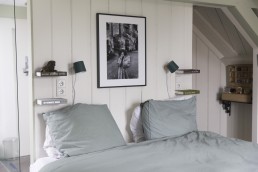Artland magazine special edition featuring 14 Dutch art collectors
Collecting art is a personal journey which each collector navigates differently. However, all have one thing in common: the joy of sharing the fruits of their journey with likeminded.
To bring some of these captivating stories to life we have compiled fourteen interviews with Dutch art collectors, whom are all different but equally passionate about sharing their personal collector journey.
Meet Sara Lang!

Lin De Mol, the blue-series // Fabio Bucciarelli, press photo
Name: Sara Lang
Location: Amsterdam
Started collecting in year: At age 21, over 15 years ago
Number of artworks in collection: 30
For Sara Lang, living without art is like living without air or food. She grew up in a family with art and enjoys having it in her life every single day – as a gallerist and as a collector. The passionate, talented minds and stories of artists is a driving force in her life, in which she serves the role as an ambassador of art challenging the existing system for the sake of art and make new stories come to live.
Photos by Saffron Pape

What is your earliest memory of art, and what led you to start collecting it?
I have vivid memories of playing on the floor in the gallery The Living Room in Amsterdam. My parents would visit many gallery openings and museum exhibitions. They would always take me and my sister along. I remember visiting artist studios, and I specifically remember the smell of the fresh paint. And till this day, I love that smell. I was predestined to collect art. My parents, coming from a very simple background, weren’t raised with much cultural baggage and they were keen on giving us as much cultural exposure as possible. From ballet, classical music, opera, theater to art. In a way, for me and my sister, there just is no way of living without art. Living without art in your life, or living without art in your home, even if you can afford it, is pure poverty to me.
What is the main motivation behind your collecting?
Artists tell stories with their works. Stories need to be told. By buying art, you make sure the story keeps on being told.
Is there a unifying element in your art collection?
There is always a personal connotation. Whether it is a piece I bought by Ulrike Rehm called “You owe me a kiss”, when my husband forgot our wedding anniversary or the beautiful street view watercolor drawing by Olga Chernysheva which depicts a young family with two daughters, just like the family I come from, and the family I now have made for myself. We fall in love with an artist, and then we let our personal story decide which piece we purchase.
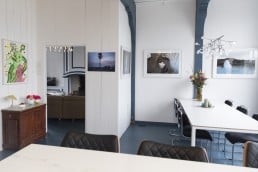
Is there a piece in your collection you have a particularly strong attachment to?
In 2004, I was accepted to an expensive Legal and Financial Master for which I had to save up money. So, I worked 40 hours a week for a year. When visiting my parents in their gallery one Saturday, I was stunned that this piece was still there! In their office they had this amazing piece by Norbert Schwontkowski “Im Dom”. They did not understand why it was one of the few pieces never sold from his exhibition. I decided to buy it, spending my money saved so far for the Master. I later decided to take a loan for the Master, and to this day, the only regret I have, is not having bought more pieces by Norbert Schwontkowski in that period, when he was still affordable and alive…
How important is it for you to meet the artist behind the artwork?
Every piece in my private collection is from an artist I know and like on a personal level. I would not buy anything from an artist I dislike. However, I would buy art from an artist I don’t know. I have a beautiful limited edition handmade photo book by Raymond Meeks and I don’t know him. But I’m sure he must be lovely person as he makes such amazing pictures.
Are there any particular artists who play a significant role in your collection and whose development you have followed closely?
Tom Heerschop is one of those artists. He makes amazing drawings. He is so talented! But he is dealing with frontal lobe syndrome after a massive brain surgery, which makes it hard for him to stay focused. Yet his drawings are still so great! This year we bought two drawings by Tom. The first was from before his operation, a drawing his now ex-wife didn’t want him to sell back in the days before his operation, the second, “Closer to my son”, I bought for my husband. It depicts a father and son intertwined in a hug. I will not give my husband a son other than this drawn one. Luckily, he is perfectly content with his two girls and his drawing by Tom Heerschop.
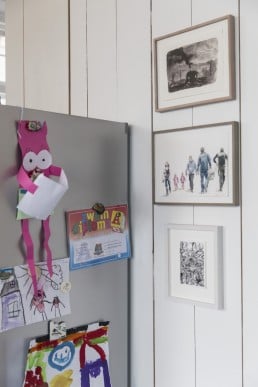
Norbert Schwontkowski // Olga Chernysheva // Kim Habers // Joe Bertrams
How has your taste changed since you started collecting?
When I met my husband, he collected antiques. His father has an antique shop in Amsterdam. I guess you could say that my husband was raised in a collector’s household like mine, with one difference however: his parents collect antique’s. My taste is pretty much a copy of my parents’. I guess our taste is somehow in our DNA. I remember when I was about 14, my parents would come home with a catalogue of an artist saying they had bought something. I would flip through the catalogue and would always guess which one they had bought.
How is the online art market evolving according to you?
The online art market, in my opinion, is great for artists without an art gallery and for dealers who work with either very low budget art or with ‘the big names’. For everything in between online is a great way to get a good general impression of the artist or the gallery. But I know how difficult it is to make a decent picture of a painting. Colors can be completely off and I also find it difficult to ‘feel’ the dimensions. Besides all that, I believe buying art is an experience. You go to the gallery, look around, talk
to the gallerists, the artist, you get exited, and then you buy! At our gallery, we celebrate a sale with a drink, and we usually home deliver the piece (sometimes with the artist) and help with the hanging, if required. You don’t just buy art, you become part of this amazing subculture called ‘the contemporary art scene’, which might make you become part of future art history.
In your opinion, what is the role of an art collector in the making of art history?
Artists have passionate, talented, beautiful minds. They think differently, they can teach us so much about society and about ourselves by telling their stories in pictures. Art enriches your life on every level. The best part of my job are the studio visits and hanging out with artists and collectors. I think everybody should have the opportunity to have art in their lives. Museums can be expensive, but galleries charge no entrance fee! I talk to everybody who comes in our gallery, albeit students or kids. Because I believe, I am more of an ambassador of art than a salesperson. Having collectors who actually buy art on a regular basis is very important, as they make art accessible to others and keep the artists alive! Without collectors, there would be no gallery. Without collectors, I could not show my artists’ works and tell their stories to whoever wants to hear them.
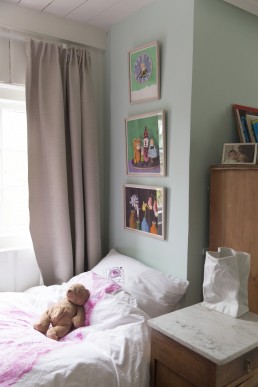
Where do you think the future of the art world is headed?
I think artists will keep on being amazing as they always have been. I hope that the art fair pressure will diminish. Participating in art fairs is expensive and very risky, as you never know how much you will sell. Nevertheless, participating in fairs is relevant for the exposure of your artists and the gallery. It is good for your reputation. It is a catch 22. You want to be in the fair, but you can easily go bankrupt on that same fair. This can only change if people get intrigued again to walk into an actually gallery instead of going to a few fairs once a year and buy solely there. We gallerists are the only ones who can change that. We need to change the system. We need to collaborate. We need to send collectors from our gallery to others and back. If we did that, we wouldn’t need art fairs.
The art market is a real market in the economic sense of the word. Currently, demand is low. But the supply seems to keep growing. Due to the internet, due to the amount of fairs and due to the amount of exhibitions. I believe that this gives art a feeling of being something “easy” and “cheap”. That’s why I believe we should make less exhibitions. It also gives us the benefit of being 100% focused and dedicated to the few exhibitions we do make. It gives the art the attention and respect it deserves more than just being a product. I’m a bit done with the people in the art scene who say “that’s how it’s always been done”, or “that’s how it’s suppose to be”. You know what? We have been doing things in our own way for so long and we are still here and doing great, if I may add! Our reputation rocks! Currently I’m sucked into a system, where I am still wrapping up my previous show (delivering works, administration), working on my current show (hard sales), planning my next show in the gallery, and focusing on the next expensive art fair. It’s crazy! From September 2018, I will change this system for myself, and I hope other galleries will follow. Less is more!
Describe your collection in three words.
Figurative. Personal. Growing.
Top three pieces of advice for new collectors
1. Don’t be afraid of sounding stupid when you talk to a gallerist or an artist. It’s their job, they are supposed to know more than you.
2. If you get a bad vibe from an artist or a gallerist, don’t buy it! Every time you’ll look at the piece hanging on your wall, that will be the story you’ll remember. Buying art is an experience. And that experience should be awesome from start to end.
3. Buy because it will make you part of something greater than just the piece you are buying. Buy with your heart.
Top three art destinations
Amsterdam, my hometown. In particular the Jordaan area. But go to Amsterdam North to discover the real cool hotspots. Milan, my mothers’ hometown. Known for its amazing fashion, art and design. Check out Piazza Gae Aulenti instead of Piazza Duomo which has lost all its charm… Last but not least New York. My husband and I lived in Manhattan in the period 2008-2009. Exhibition openings are real happenings there, even during the financial crisis. People dress up, actually look at the works and discuss it.
Three inspiring artists to watch
I would say: all artists! But I guess I should give three names… Which is hard for a gallerists as I should professionally name three of my artists… But the three artists I am looking out to buy a piece from are: Raymond Meeks, Guglielmo Castelli, and Lynn Leegte.
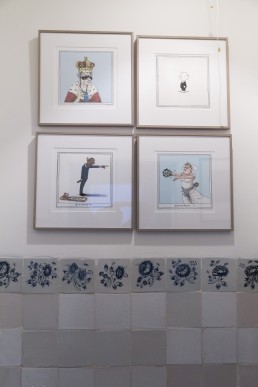
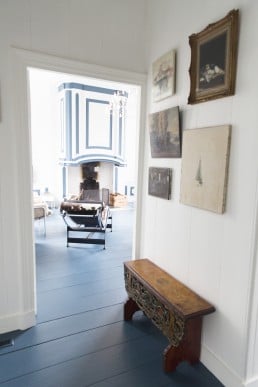
Norbert Schwontkowski // Ulrike Rehm, you owe me a kiss
